Vizio Thin+Light CT15: Something New and Edgy
by Vivek Gowri on February 14, 2013 9:00 AM EST- Posted in
- Laptops
- Intel
- IPS
- Ivy Bridge
- Vizio
- Ultraportable
- Ultrabook
I’m going to run through our benchmark suite pretty quickly, because we’re pretty familiar with the ultra low voltage Ivy Bridge parts by now. The i7-3517U is the most common ULV i7 SKU, and the second most common Ultrabook part after the i5-3317U. Clock speed of 1.9GHz, max turbo of 3.0GHz, and HD4000 are all part of the package.
| Laptop Configuration Overview | ||||
| Laptop | CPU | Graphics | Storage | Battery |
| Acer Aspire S3-951-6432 | Intel i7-2637M | HD3000 | 256GB SSD | 38Wh |
| Acer Aspire S5-391-9860 | Intel i7-3517U | HD4000 | 2x128GB SSD | 35Wh |
| Acer Aspire S7-391-9886 | Intel i7-3517U | HD4000 | 2x128GB SSD | 35Wh |
| Apple MacBook Air 13 (Mid-2012) | Intel i5-3427U | HD4000 | 256GB SSD | 50Wh |
| ASUS Zenbook Prime UX31A-DB71 | Intel i7-3517U | HD4000 | 256GB SSD | 50Wh |
| Dell XPS 13 | Intel i7-2637M | HD3000 | 256GB SSD | 47Wh |
| HP Envy 14 Spectre | Intel i7-3667U | HD4000 | 2x128GB SSDs | 56Wh |
| HP Folio 13 | Intel i5-2467M | HD3000 | 128GB SSD | 60Wh |
| Intel IVB Ultrabook Prototype | Intel i5-3427U | HD4000 | 240GB SSD | 47Wh |
| Toshiba Satellite U845-S406 | Intel i5-3317U | HD4000 | 500+32GB Hybrid | 54Wh |
| Toshiba Satellite U845W-S410 | Intel i5-3317U | HD4000 | 500+32GB Hybrid | 54Wh |
| Vizio Thin+Light CT15-A5 | Intel i7-3517U | HD4000 | 256GB SSD | 52Wh |
Performance is very much in line with the Acer Aspire S7 that Jarred reviewed, with the main difference between the two systems being Vizio’s single Toshiba 256GB SSD versus Acer’s two 128GB Lite-On drives in RAID 0 and the extra RAM in the Acer. Again, being limited to 4GB of memory in the Vizio is a bit annoying, but in the grand scheme probably not a huge deal for most. I’ve recently been dealing with a number of systems with only 4GB RAM—MacBook Air, Surface Pro, other Ivy Bridge tablets, my trusty ASUS Zenbook Prime—and they’ve all held up well in casual use. I think anything less than 8GB RAM is a bit rough for any serious system, but 4GB is a livable limit for a machine in this class.
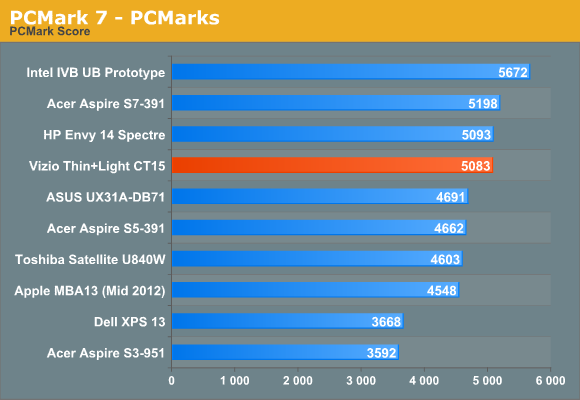
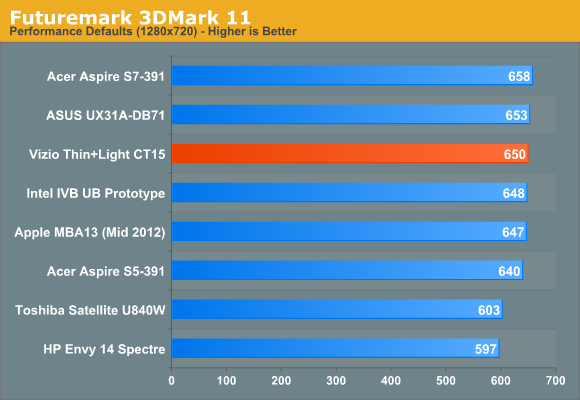
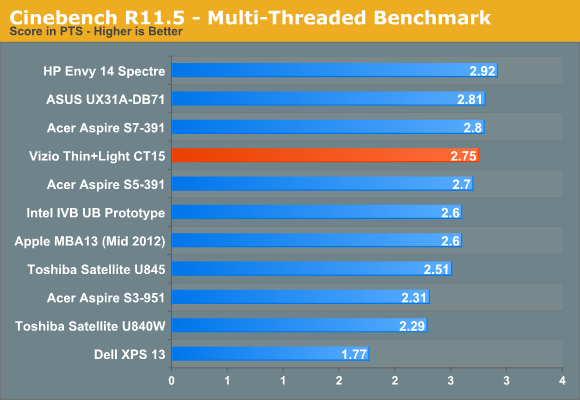
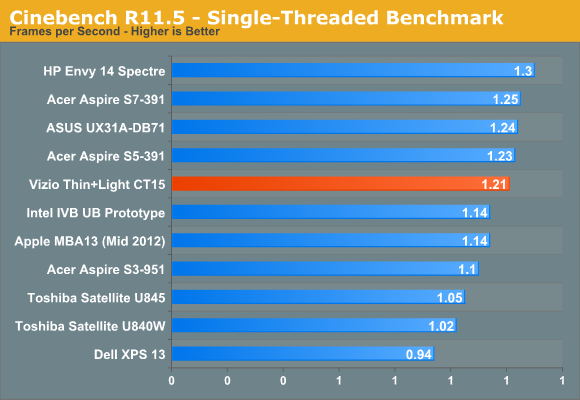
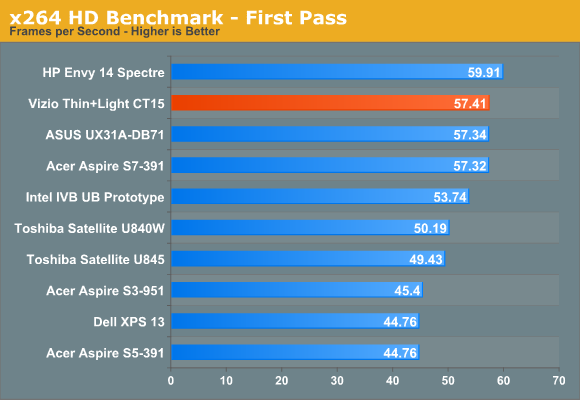
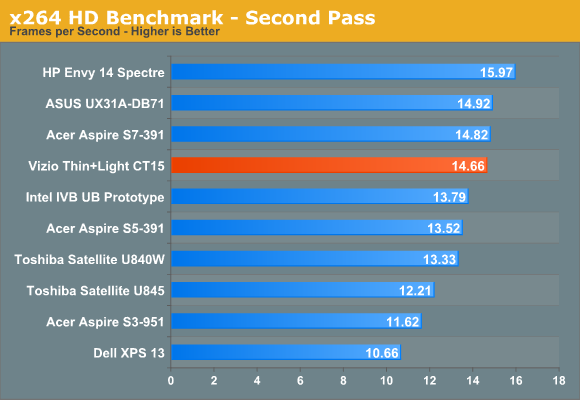
The CT15 has a 52Wh 6-cell li-poly battery that theoretically gives it decent battery life. Unfortunately, it doesn’t really hold up to that in real life, though you can point to a few reasons for that. We saw around five hours in our ideal case test and a hair over four in our internet test that tends to be a better barometer of what you can expect in typical daily use.
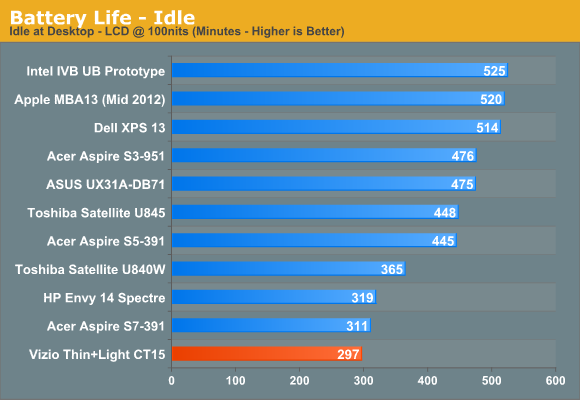
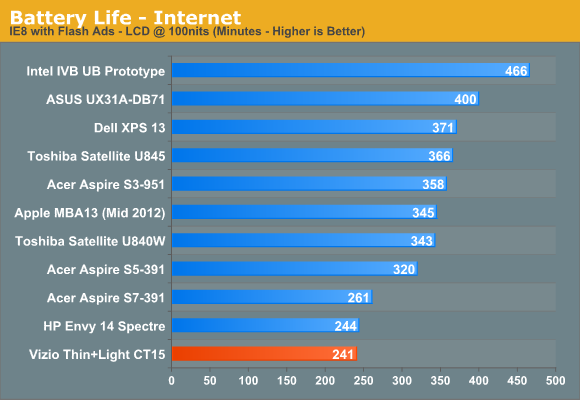

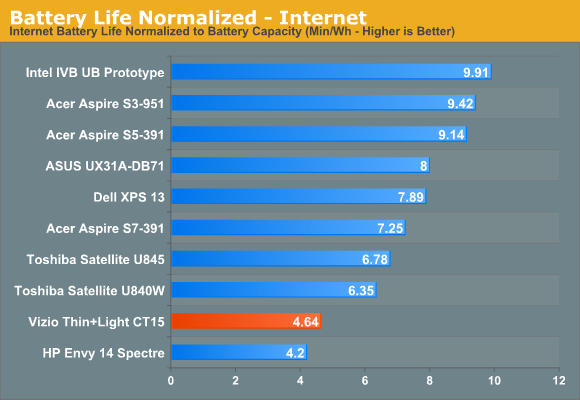
Those numbers seem low, as does the three hours and change in our HD video benchmark, but I think the main culprit is the 1080p 15.6” display. The increase in display size and resolution easily accounts for the increase in overall power draw compared to the 13” Ultrabooks we’ve seen thus far. Other than the Vizio and the HP Envy Spectre, every other notebook in the graphs is a 13” Ultrabook, which is why both the Vizio and the HP come off looking quite poor. Apple went with a 95Wh battery for the Retina MacBook Pro to end up at the 7 hour mark, versus 77.5Wh for the regular 15” MBP and 63.5Wh for the 13” (all three of which end up in the 7-8 hour range for battery life) so you can see how the 52Wh battery results in a relatively low runtime even with a ULV processor.
This issue gets fixed in the next-gen touchscreen Thin+Light, which has “nearly double” the capacity. I doubt it gets to the 100Wh mark, but even if it ends up near the 15” MacBook Pro in terms of capacity, it should be good enough for something along the lines of 6-7 hours of real world usage.










55 Comments
View All Comments
tipoo - Thursday, February 14, 2013 - link
More cache too I believe.Death666Angel - Friday, February 15, 2013 - link
3MB on i5 vs 4MB on i7, yes.xaml - Saturday, February 16, 2013 - link
In a Freudian slip of sorts, Dell put an i5 sticker on my XPS 14 (2012) powered by an i7.StephaneP - Thursday, February 14, 2013 - link
It's all in the subject. I'm surprised that these informations are not in this review.tipoo - Thursday, February 14, 2013 - link
With the Windows 8 multitouch driver, I have zero problems with the touchpad on my 3 year old Dell Studio 15, actually it's pretty good. It's not Mac good, but I'd say something like 80% as good which is good enough for me. The bad input rejection is just right, there is smooth scrolling throughout the OS, good pinch to zoom, etc etc.So would all Vizios you could order now have a Synaptics pad instead of the horrid old one? How can we make sure?
VivekGowri - Thursday, February 14, 2013 - link
All of the Windows 7 ones came with Sentelic touchpads (CT15-A0, A1, A2), while the Windows 8 ones have Synaptics touchpads (A4, A5). A small, but very important, hardware update that came at the same time as the Windows 8 refresh.tipoo - Thursday, February 14, 2013 - link
Awesome, thanks.PEJUman - Thursday, February 14, 2013 - link
I have the following systems: 48GB in x58 970, 16GB on H77 3770, 8GB on P45 Q9650, 8GB on Hudson (AMD C-60) and 4GB on QM77 3217 @ Acer W700. the only way I can use more than 4GB on serious use is by disabling PF. (It is disabled on the 8GB+ systems). the 48GB system is actually used for Ramdrives and VMs. I cannot tell the difference between responsiveness under load (simultaneous encodes/virus scans + browsing/word/excel/ppt/matlab) across these devices; with the exception of the C-60, and that thing got 8GB.To the ultrabook point, I found 4GB is sufficient for occasional power use (even encoding/rippings via DBpowerAmp, quicksync or handbrake). I think the 4GB + SSD IOPs for PF is a good combo and I can't think of any usage pattern that would need more, esp. when the CPU speeds and/or cores counts less than 4. I actually rather take the $20 discount on price than additional 4GB for my mobile devices, they simply become obsolete way too fast nowdays to held any kind of monetary value. I much rather get them cheap & offload them quickly when I upgrade the next year.
My mobile devices are mostly throttled (thermally) on loads that can use 4GB+. so I think present ultrabook thermal constraints is the weakest link in their performance, not RAM or PF speeds.
Huge database on excel, CADs or matlab might cross the 4GB line, but for those you'll probably will be working on a 1600p or multiple 1080p screens (AKA desktop) anyway.
Netscorer - Thursday, February 14, 2013 - link
I owned briefly their first-gen Thin+Light that was available in October for $600 (talk about value!). same form factor, just slightly downspecced with core i5 and 14" 1600x900 display. Loved form factor! Best ultrabook design right after leaders in ASUS and Apple. The three biggest complaints from the users for that generation were (in order)- keyboard
- battery life
- lack of ports.
When I read this review it's like deja vu all over again. Same lackluster keyboard, same disappointing battery life and again no ports beyond bare minimum. Now, if these factors are not critical to you, I would recommend this laptop heartily. It's very sharp looking, has great IPS display and specs that would satisfy all but gamers and developers.
VivekGowri - Thursday, February 14, 2013 - link
No, the absolute number one worst thing about the first-gen system was the touchpad, without question. And I mean, this is the same laptop, just with Windows 8 and a new Synaptics touchpad.Keyboard and battery are getting fixed with the touchscreen ones, and you can cry about lack of ports all day long but on an ultrabook you're just not going to get any semblance of decent port selection. The only thing I feel like could be a reasonably expected addition is an SD card slot. Just be happy it has a full-size HDMI instead of this smartphone-grade micro HDMI stuff that ASUS is using on the Zenbook Prime.